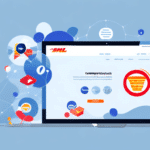Introduction: Integrating DHL eCommerce with Salesforce
In the competitive landscape of eCommerce, seamless integration between shipping solutions and customer relationship management (CRM) platforms is essential. DHL eCommerce offers a robust shipping and delivery service that integrates seamlessly with Salesforce, allowing businesses to streamline their operations, enhance customer satisfaction, and gain valuable insights into their shipping processes. This guide explores the benefits of integrating DHL eCommerce with Salesforce, provides a step-by-step connection process, and shares best practices for optimizing this integration.
Benefits of Integrating DHL eCommerce with Salesforce
Integrating DHL eCommerce with Salesforce offers numerous advantages for businesses of all sizes:
- Reduced Manual Data Entry: Automation eliminates the need for repetitive data entry, reducing errors and saving time.
- Efficient Shipment Tracking: Real-time tracking enhances visibility into shipping statuses, improving operational efficiency.
- Enhanced Customer Satisfaction: Faster and more reliable shipping options lead to happier customers and increased loyalty.
- Cost Optimization: Access to detailed shipping data helps businesses identify cost-saving opportunities.
- Data-Driven Insights: Analyze shipping performance to make informed decisions and optimize processes.
According to a recent Forbes report, businesses that integrate their shipping solutions with CRM platforms like Salesforce see a significant improvement in operational efficiency and customer satisfaction.
How to Connect DHL eCommerce with Salesforce: A Step-by-Step Guide
Setting up the integration between DHL eCommerce and Salesforce is straightforward. Follow these steps to get started:
- Create Accounts: Ensure you have active accounts for both Salesforce and DHL eCommerce.
- Access Salesforce AppExchange: Log in to your Salesforce account and navigate to the AppExchange.
- Install DHL eCommerce App: Search for the DHL eCommerce application and proceed with the installation.
- Configure Integration Settings: After installation, go to Salesforce Setup and select DHL eCommerce Settings. Enter your DHL eCommerce credentials and save the configuration.
- Select Shipping Method: In Salesforce, navigate to the shipping methods section and select DHL eCommerce for your shipments.
For detailed troubleshooting and support, refer to DHL eCommerce’s customer support.
Optimizing and Managing Your DHL eCommerce Integration
To maximize the benefits of your DHL eCommerce and Salesforce integration, consider the following optimization strategies:
- Update Account Settings: Regularly review and update your DHL eCommerce account settings to reflect any changes in your business operations.
- Customize Shipping Rules: Utilize Salesforce’s customization options to create shipping rules and workflows tailored to your business needs.
- Analyze Shipping Data: Use Salesforce reports and dashboards to monitor shipping performance and identify areas for improvement.
- Leverage International Shipping: Take advantage of DHL eCommerce’s global shipping options to expand your market reach.
- Optimize Packaging: Ensure that your packaging is suitable for shipping to reduce damage and improve delivery times.
Implementing these strategies can lead to a more efficient and cost-effective shipping process, ultimately enhancing your overall business performance.
Overcoming Common Challenges in DHL eCommerce-Salesforce Integration
While integrating DHL eCommerce with Salesforce offers many benefits, businesses may encounter certain challenges:
- Delivery Delays: Coordinate with DHL eCommerce to establish clear communication channels and provide customers with accurate delivery timelines.
- Shipment Tracking Issues: Utilize Salesforce’s tracking features and ensure that all shipment data is accurately entered to maintain real-time visibility.
- Data Security Concerns: Implement robust security measures such as two-factor authentication, data encryption, and regular security audits to protect sensitive information.
- Customer Service Integration: Train customer support teams to handle inquiries related to shipping and ensure they have access to necessary shipment data.
Addressing these challenges proactively can mitigate potential disruptions and ensure a smooth integration process.
Enhancing Salesforce Experience with DHL eCommerce Features
DHL eCommerce offers a suite of features that enhance the Salesforce experience:
- Real-Time Shipping Rates: Access up-to-date shipping rates directly within Salesforce, allowing for accurate cost calculations.
- Advanced Tracking: Monitor shipments in real-time and receive updates within the Salesforce platform.
- Customizable Shipping Options: Tailor shipping settings to meet the specific needs of your business and customers.
- End-to-End Delivery Services: Manage the entire delivery process, including returns and customer support, from within Salesforce.
- Automated Notifications: Set up automated email and SMS notifications to keep customers informed about their shipment status.
These features streamline the shipping process, reduce manual efforts, and provide a better overall user experience within Salesforce.
Tracking Shipments and Boosting Customer Satisfaction
Effective tracking is crucial for maintaining transparency and trust with customers. Here’s how to leverage Salesforce for tracking DHL eCommerce shipments:
- Shipment Details Page: Access detailed shipment information and tracking links directly from Salesforce.
- Salesforce Dashboards: Utilize dashboards to visualize shipment statuses and monitor overall shipping performance.
- Automated Notifications: Configure Salesforce to send automatic updates to customers regarding their shipment status.
- Real-Time Updates: Provide customers with real-time tracking information to enhance their experience and satisfaction.
Implementing these tracking strategies can significantly improve customer satisfaction by keeping customers informed and reducing uncertainty about their orders.
Improving Customer Satisfaction Through Efficient Delivery
Efficient delivery processes directly impact customer satisfaction. Consider the following tips to enhance customer experience:
- Offer Multiple Shipping Options: Provide customers with choices such as express, standard, and economy shipping to meet their preferences.
- Provide Accurate Delivery Estimates: Ensure that delivery timelines are realistic to manage customer expectations effectively.
- Implement Flexible Delivery Choices: Allow customers to choose delivery dates and times, or offer alternative delivery locations.
- Streamline Returns Management: Make the returns process easy and hassle-free to build trust and encourage repeat business.
By focusing on these areas, businesses can foster stronger customer relationships and drive higher levels of satisfaction and loyalty.
Case Studies: Real-Life Success Stories
Several businesses have successfully integrated DHL eCommerce with Salesforce, leading to significant improvements in their operations:
XYZ Corporation
XYZ Corporation, an eCommerce retailer, experienced a 20% increase in customer satisfaction after integrating DHL eCommerce with Salesforce. The integration enabled them to offer faster shipping options, provide real-time tracking to customers, and automate shipping notifications, resulting in a more efficient and customer-friendly shipping process.
ABC Enterprises
ABC Enterprises streamlined their shipping operations by integrating DHL eCommerce with Salesforce. This integration reduced manual data entry by 30% and improved shipment accuracy, leading to lower return rates and higher customer trust.
Future Trends in DHL eCommerce and Salesforce Integration
The future of eCommerce integration lies in leveraging advanced technologies to enhance efficiency and customer experience. Key trends to watch include:
- Artificial Intelligence and Machine Learning: Utilize AI to predict shipping trends, optimize routes, and personalize customer experiences.
- Enhanced Data Analytics: Advanced analytics will provide deeper insights into shipping performance and customer behavior.
- Omnichannel Integration: Seamless integration across various sales channels to provide a unified customer experience.
- Automation and Robotics: Implement automated processes and robotics to further reduce manual efforts and increase speed.
- Sustainability Initiatives: Focus on eco-friendly shipping options and sustainable practices to meet customer and regulatory demands.
Staying updated with these trends will help businesses maintain a competitive edge and continuously improve their shipping and CRM strategies.
Conclusion
Integrating DHL eCommerce with Salesforce offers a powerful combination for businesses seeking to optimize their shipping and customer relationship management processes. By following the step-by-step guide, implementing best practices, and leveraging the advanced features offered by both platforms, businesses can enhance operational efficiency, reduce costs, and significantly improve customer satisfaction. As eCommerce continues to evolve, staying ahead with robust integrations like DHL eCommerce and Salesforce will be key to sustained growth and success.




















